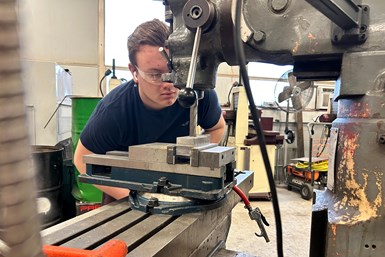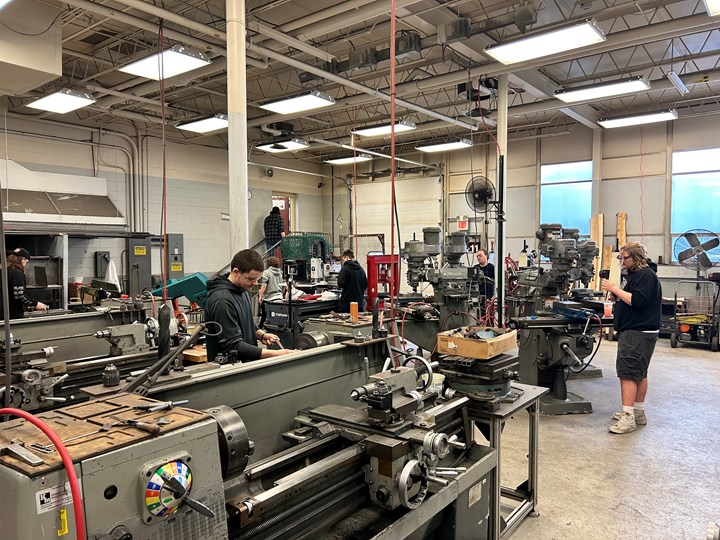The Resurgence of 'Shop Class' in American High Schools
From the 1990s through the 2010s, most traditional “shop classes” disappeared from middle schools and high schools across the U.S. — one of the many issues that helped create today’s skilled labor shortage in metalworking and CNC machine shops. Here’s one solution that deserves more attention.
Share




Edgar was a pain in the neck.
Or maybe we should say, it was difficult for some of the teachers at Edgar’s high school to appreciate his distinct learning style. Edgar was disruptive. He had a smart mouth and tried to talk his way out of everything, including his poor grades in core classes.

Today, barely out of high school, Edgar is the lead foreman for a California-based union carpentry company that designs and builds upscale retail shops for high-end clients like Louis Vuitton. He is well established on a lucrative career path at a time when some of his former classmates are still racking up debt at four-year colleges.
Not everyone at Edgar’s high school considered him to be a problem student. Kirk Shafer, who today works as the career and technical education (CTE) director at Brandywine High School in Niles, Michigan, never understood what all the fuss was about when it came to Edgar. In the eyes of Shafer — an experienced woodworker as well as Edgar’s former woodshop instructor at a different school — Edgar was the model student.
“I knew he'd be successful,” Shafer told me recently. “But the other teachers couldn’t handle him. And that always confused me. He was my best student! I love that kid. He was a talker. He was mischievous. He just was in the wrong environment.”
Among the tangle of events in the early 21st century that would hamstring the U.S. manufacturing base for at least a decade sat the No Child Left Behind Act, the sweeping public school reform act passed with bipartisan support and signed into law in 2002.
At the heart of the act was the creation of federal guidelines for student achievement that were measured through annual standardized tests. The results of these tests, focused on reading and math and administered by the states, were the core metrics used to evaluate school performance, teacher performance and school funding.
Here’s how Shafer explains the impact that No Child Left Behind had on CTE: “The CTE classes were non-core classes,” he says. “The law made the requirements to graduate much more stringent, and since the CTE classes were non-core classes, students didn’t have as much access to them anymore. Even the students who were struggling in their core classes, who are sometimes our best students because they excel with hands-on learning, didn’t have time in their schedules anymore.”
If you have ever wondered why “shop” classes disappeared from many public schools during the aughts and early 2010s, this is part of the reason why.
The good news is that state school systems across the country, like Brandywine Middle/High School, are beginning to figure out solutions. Brandywine is part of a consortium of school districts in Berrien County that operate under a model, approved by the Michigan Department of Education, in which individual school districts can partner and share a range of CTE programs among students within the county. In other words, students at one high school can attend CTE programs at other schools.
Brandywine’s CTE program offers metalworking/machining, mechanical drafting, as well as a woodworking/cabinet making program, auto shop and others. Students enrolled in these programs often travel from other schools to attend classes at Brandywine, with transportation between schools provided. Crucially, some of the courses in these programs count as math credits.
Another nuance: In Michigan, teaching a secondary CTE program requires two years or 4,000 hours of “recent and relevant” experience in the occupational area. All 4,000 hours may come from direct business or industry experience. The level of required experience varies between states, but these guidelines recognize that hiring qualified instructors for something like Brandywine’s machine tool program is difficult enough without requiring a teaching certificate or degree on top of industry experience.
Individual state funding for CTE programs, along with other revenue sources like federal Perkins grants, are providing vital support for a manufacturing industry desperate for talent. But as Shafer knows, given the industry’s needs — as well as those of students with different learning styles and aspirations — these sources are still far from sufficient.
Shafer is trying to raise the funds needed to build the Brandywine Manufacturing Center — a new building that will house equipment to serve the three disciplines that fall under the system’s manufacturing umbrella (a machine tool discipline, cabinet making, and mechanical drafting). Shafer is in the middle of negotiations with local businesses for funding and naming rights.
Smart business leaders will see the opportunity here. Just as state and federal education departments immediately need to increase support for CTE programs around the country, solving the skilled worker crisis in the American manufacturing industry will require that businesses put more skin in the game.
And why wouldn’t they? The data alone provides the evidence: The Michigan Department of Education says that 95% of high school students enrolled in a CTE program graduated in 2022. Michigan’s overall graduation rate? 81%. Even the federal Department of Education touts this statistic on its CTE website: Eight years after their expected graduation date, students who focused on CTE courses while in high school had higher median annual earnings than students who did not focus on CTE.
And as long as we’re making righteous demands, I ask our overworked and underpaid middle- and high-school teachers and counselors to recognize the vital role that CTE programs play for kids who may not excel in traditional classroom settings. So when the next Edgar strides into the room, you’ll know what to do.
Read Next
5 Rules of Thumb for Buying CNC Machine Tools
Use these tips to carefully plan your machine tool purchases and to avoid regretting your decision later.
Read MoreSetting Up the Building Blocks for a Digital Factory
Woodward Inc. spent over a year developing an API to connect machines to its digital factory. Caron Engineering’s MiConnect has cut most of this process while also granting the shop greater access to machine information.
Read MoreBuilding Out a Foundation for Student Machinists
Autodesk and Haas have teamed up to produce an introductory course for students that covers the basics of CAD, CAM and CNC while providing them with a portfolio part.
Read More

























